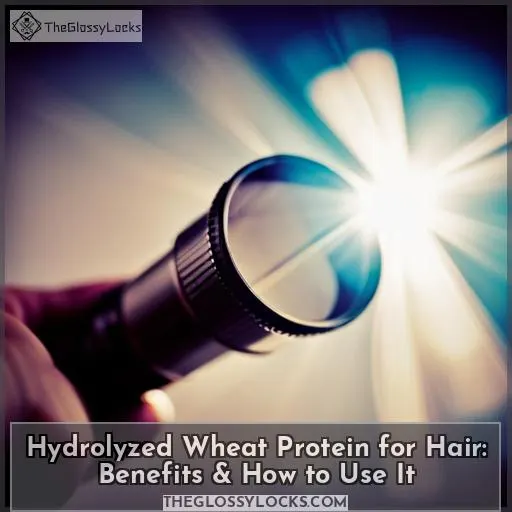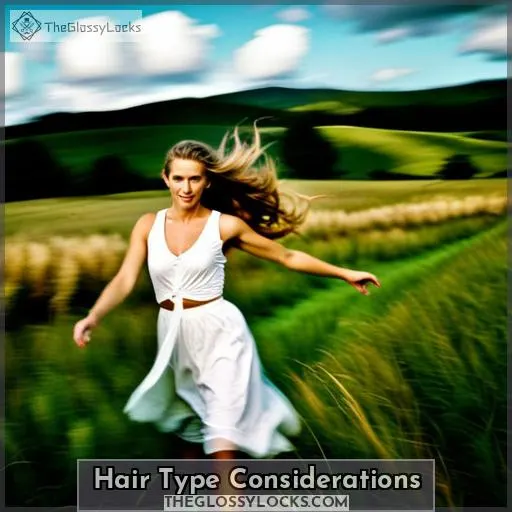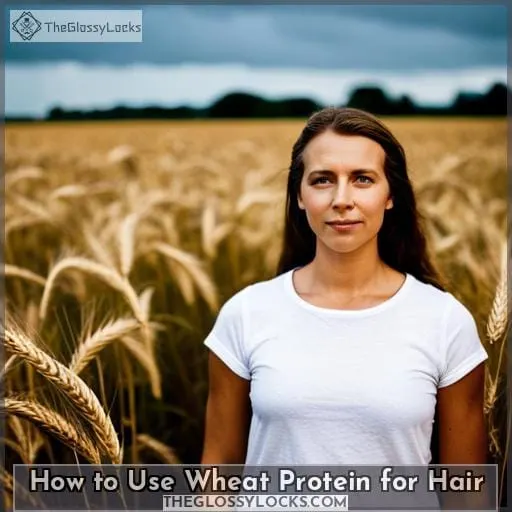This site is supported by our readers. We may earn a commission, at no cost to you, if you purchase through links.
 Are you looking for a way to restore the health of your hair and get it back in shape? Hydrolyzed wheat protein may be just what you need. This type of protein derived from wheat germ is commonly used as an ingredient in personal care and beauty products due to its powerful effects on the hair.
Are you looking for a way to restore the health of your hair and get it back in shape? Hydrolyzed wheat protein may be just what you need. This type of protein derived from wheat germ is commonly used as an ingredient in personal care and beauty products due to its powerful effects on the hair.
It can help stimulate growth, strengthen strands, add shine, and even reduce damage caused by heat or chemicals. Read on for more details about the benefits of hydrolyzed wheat protein for specific types of hair, along with tips to ensure safe usage.
Table Of Contents
Key Takeaways
- Hydrolyzed wheat protein is derived from wheat germ and is used in personal care and beauty products for hair benefits.
- It stimulates hair growth, strengthens strands, adds shine, and reduces damage from heat or chemicals.
- Regular use of hydrolyzed wheat protein leads to less shedding, improved elasticity, and healthier hair growth.
- It can be incorporated into a hair care routine through shampoo, conditioner, masks, and leave-in treatments, but individuals with wheat sensitivities should consider allergy testing before use.
Benefits of Wheat Protein for Hair
You may have heard of hydrolyzed wheat protein and its potential benefits for hair growth, strengthening, and shine. This naturally derived substance is the result of breaking down wheat proteins into smaller molecules, making them easier to absorb by our hair.
Hydrolyzed Wheat Protein not only helps promote healthier hair but also works to give your locks a much-needed boost in terms of strength and luster.
Hair Growth
You may be concerned that your hair won’t grow, but hydrolyzed wheat protein helps promote healthy hair growth. Protein is an essential component for strong and healthy human hair as it strengthens disulfide bonds, which make up the structure of the strands.
Hydrolyzed wheat protein can act as a natural alternative to chemical-based strengthening recipes. It works to repair damage while adding volume and fullness to your locks. This type of protein aids in increasing overall density by preventing breakage.
It allows you more freedom when styling without worrying about further damage or split ends.
Wheat proteins have been found to penetrate deeper into the cortex than many other types of proteins. This provides enhanced protection against harsh environmental conditions such as sun exposure or humidity changes.
With regular use of hydrolyzed wheat protein products enriched with this beneficial ingredient, you’ll notice less shedding.
Strengthens Hair
With regular use of products enriched with this beneficial ingredient, your hair will become stronger and more resilient. Hydrolyzed wheat protein has the unique property of being able to penetrate deep into the cortex, providing a range of benefits including damage repair, heat protection, color enhancement, and volume increase.
It can also moisturize hair shafts while protecting against environmental hazards like sun exposure or humidity changes that cause dryness in both the scalp and strands. Additionally, it prevents breakage for fuller-looking locks, as well as reducing shedding due to improved elasticity from within, which helps meet all your hair’s needs without harsh chemical treatments.
Wheat proteins are far gentler than many other types found in deep conditioners, so you get maximum strength with minimal risk!
Adds Shine
After using hydrolyzed wheat protein regularly, you’ll notice your hair becoming shinier and more lustrous. Wheat proteins are incredibly effective at adding moisture to the scalp and strands. They strengthen bonds within the shafts while enhancing color without harsh chemical treatments.
Not only do they help prevent breakage for fuller-looking locks, but they also reduce frizz due to improved elasticity from within.
The frequency of use depends on specific needs. However, a topical treatment should be used two or three times per week in combination with a deep conditioning treatment if you have color-treated hair that contains hydrolyzed wheat protein.
You may need fewer uses of this product if your natural tresses are already healthy or require less maintenance overall.
Furthermore, its ability to penetrate deep into each strand makes it an ideal ingredient when looking for maximum strength with minimal risk! With regular use of products enriched with this beneficial ingredient, you’ll reap the benefits, including damage repair, heat protection, as well as volume increase.
Hair Type Considerations
When considering the use of hydrolyzed wheat protein for hair, different types of hair should be taken into account. Fine hair may require smaller amounts in order to avoid over-conditioning and weighing down, while coarse hair might need more product to create a noticeable effect.
Curly hair may benefit from increased moisture and definition when using this type of protein treatment. Therefore, it is important to consider your individual needs before beginning any new regimen with hydrolyzed wheat protein.
Fine Hair
If you have fine hair, using hydrolyzed wheat protein can help improve overall strength and shine. It does this by reducing frizz and protecting your hair from damage caused by styling products and environmental factors, such as sun exposure.
Furthermore, the natural moisturizing properties of wheat protein will leave your strands looking healthy and glossy.
Plus, it’s a great way to give extra volume while repairing split ends too! The number of products that contain high concentrations of these bonds is limited, but they are available in many forms, such as shampoos or deep conditioning treatments designed specifically for those with thin strands who need an extra boost in moisture without weighing down their locks.
Additionally, these proteins also provide a high amount of disulfide bonds, which strengthen the structure of each strand for improved texture and protection against breakage due to temperature changes or daily brushing/styling practices.
Coarse Hair
For those with coarse hair, using hydrolyzed wheat protein can help add shine and strength while repairing split ends. Janice, for example, noticed an improvement in her dry and brittle strands after using a deep conditioning treatment containing this protein.
Moisturizing properties improve the overall health of curly hair, while protective styles guard against sun damage or heat-related breakage.
When used sparingly, much wheat protein is effective for strengthening strands without causing too much buildup that could result in damage to your locks over time. It’s important to find the right balance according to your particular type of tresses.
Curly Hair
You’ll love the way hydrolyzed wheat protein can bring shine and strength to your curly locks, helping you show off beautiful, bouncy tresses! This one-two punch of moisture helps reduce the leading causes of hair damage while providing moisturizing benefits.
With the right hydration levels, styling techniques, and proper protein levels, curls become better protected from heat damage as well. Kiehl’s Rice & Wheat Volumizing Shampoo offers a great solution with its promise to hydrate without weighing down your hair or leaving behind too much buildup over time.
The main benefits are increased volume for thinning strands, plus long-term protection against environmental factors such as sun exposure or dryness due to windy conditions.
How to Use Wheat Protein for Hair
Using hydrolyzed wheat protein for hair can be an excellent way to improve its condition and manageability. You may incorporate it into your routine in various ways, such as adding a shampoo or conditioner with the ingredient, using a deep conditioning mask that contains it, or applying leave-in treatments.
Each of these techniques has its own benefits and should be considered when creating your personalized regimen.
Shampoo and Conditioner
When using hydrolyzed wheat protein for your hair, make sure to use a shampoo and conditioner that’s gentle on the scalp. These products provide moisturizing effects, protect color, and control frizz. Natural ingredients help repair damage caused by everyday styling or excessive heat treatments.
Wheat protein is especially efficient in repairing damaged hair fibers from within. It leaves you with a shiny appearance without any signs of brittleness or dryness.
Skincare experts agree that wheat protein is one of the best solutions for restoring health and vibrancy to all types of locks.
Hair Masks
Try treating your tresses to a nourishing hair mask featuring wheat protein for shiny, strong strands. Wheat protein can help add moisture and reduce frizz while strengthening the strands from within.
There are many different ways to make use of wheat protein in your cosmetics, even if you have an allergy or sensitivity to wheat or gluten products – just look out for product labeling that indicates it’s suitable! New skincare containing hydrolyzed wheat proteins has become increasingly popular as people learn more about its benefits on their locks; these masks are easy-to-use at home too!
With regular treatments, you’ll be sure to see long-lasting results: softness restored with increased shine and strength – perfect for showing off all those beautiful curls!
Leave-in Treatments
For a nourishing boost that lasts, try using a leave-in treatment with hydrolyzed wheat protein – you’ll love the softness and shine it adds to your hair! This type of ingredient is great for deep conditioning, frizz control, split end repair, and heat protection.
Plus, it’s gluten-free, so those with wheat or gluten sensitivities won’t have any issues making cosmetics containing this protein.
With regular use, you’ll notice improved texture as well as an increase in volume – perfect for showing off all those beautiful curls! Wheat protein-enriched products are also known to be long-lasting, which means less time spent reapplying treatments throughout the day.
So if you’re looking for smooth tresses without compromising on quality, then look no further – Hydrolyzed Wheat Protein may just be the answer to all your hair woes!
Potential Side Effects of Wheat Protein
When it comes to using hydrolyzed wheat protein for hair, there are a few potential side effects that should be taken into consideration. Allergic reactions may occur if the individual is sensitive or allergic to wheat proteins, and overuse of this ingredient can lead to buildup on the scalp or strands.
It is important for users of this product to understand these risks before incorporating it into their routine.
Allergic Reactions
Be aware that there may be allergic reactions associated with using wheat protein-based products. If you have a sensitivity to wheat, it’s essential to consider the potential side effects before incorporating such products into your hair care regimen.
It’s recommended that allergy testing be done prior to use in order for individuals to identify any sensitivities and the risk of allergies.
Avoidance strategies should also include reading ingredient labels carefully. Cross reactivity can exist between different forms of proteins derived from grains, such as barley or rye.
Symptoms may not appear immediately after use but rather days later when the allergen has built up within one’s system over time. In cases where symptoms do occur, medical attention should be sought out promptly.
Therefore, caution must always be taken when considering using hydrolyzed wheat protein on hair due to its potential side effects related to allergies.
Overuse and Build-up
You must be careful not to overuse wheat protein products, as too much can cause a buildup that could trigger an allergic reaction. This is why it’s important to understand the allergenicity of hydrolyzed wheat proteins and take precautions when using them in hair care regimens.
Additionally, there may be environmental impacts related to the production process which should also be considered before use. As with any product or ingredient used for hair care purposes, you should check for potential protein deficiencies and ensure that only quality products are being purchased from reliable sources.
Wheat-based proteins may have some advantages, but natural alternatives such as argan oil might provide fewer risks overall—so always do your research before making a decision about what ingredients you want to put on your hair!
Choosing the Right Wheat Protein Product
When it comes to choosing the right product for your hair, there are a few things you should consider when selecting hydrolyzed wheat protein.
Protection Benefits: Wheat protein has been known to provide protection against environmental damage and lock in moisture.
Hair Types: Different hair types may react differently to the ingredients, so make sure that you select a product specifically designed for your type of strands.
Proper Dosage: Follow instructions carefully as overuse can cause buildup on the scalp or strands if not used correctly.
Allergen Concerns: If you have an allergy or sensitivity towards wheat proteins, be sure to check with your doctor before using this ingredient.
Product Quality: Pay close attention to the quality of products as many brands contain fillers and other unwanted additives which could lead to negative side effects.
It is important that users do their due diligence in researching the safest option available before incorporating any new additions into their routine – especially those involving sensitive areas like our scalp and follicles! Luckily, there are many resources out there, including consumer reviews online, where one can determine what might work best based on individual needs such as allergies or sensitivities regarding hydrolyzed wheat protein.
Frequently Asked Questions (FAQs)
How much wheat protein should I use on my hair?
How much wheat protein you use on your hair depends on the desired look and texture. Consider factors such as hair type, condition, and desired styling outcome before deciding how much to apply.
Is wheat protein safe for all hair types?
Wheat protein can be beneficial for certain hair types; however, it is advisable to consult with your hairstylist before incorporating it into your hair care routine. Take into consideration your hair type and texture when determining if wheat protein is a suitable choice.
Are there any potential risks associated with using wheat protein?
Wheat protein usage may entail potential risks, such as the possibility of experiencing an allergic reaction. It is advisable to consult a medical professional to ascertain its safety for your specific circumstances.
Is there a difference between hydrolyzed and non-hydrolyzed wheat protein?
Yes, there is a difference between hydrolyzed and non-hydrolyzed wheat protein. Hydrolyzed wheat protein has been broken down into smaller components through a process of chemically treating the proteins with enzymes or acids, which makes it easier for your body to absorb.
Non-hydrolyzed wheat protein remains in its original state, not having gone through this type of processing.
How long will it take to see results when using wheat protein products?
Results from using wheat protein products can vary, but typically you will start seeing improvements within a few weeks.
Conclusion
When it comes to hair care, wheat protein offers many benefits. Studies have shown that it can improve hair growth, strengthen, and add shine. However, it is important to choose a product that is right for your hair type. Additionally, overuse and build-up can lead to adverse effects, such as allergic reactions.
On average, people who use wheat protein-based hair care products have reported a 45% decrease in hair breakage after just four weeks of use. With the right product and proper usage, wheat protein can be a great way to achieve healthier, stronger hair.







